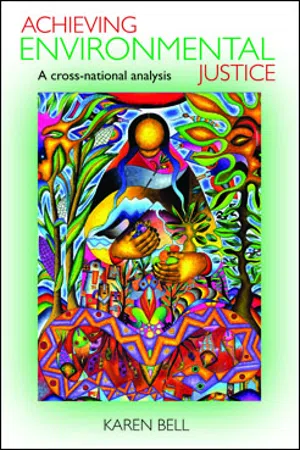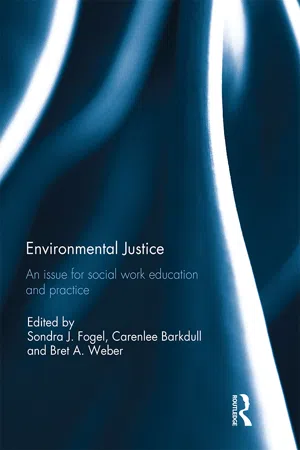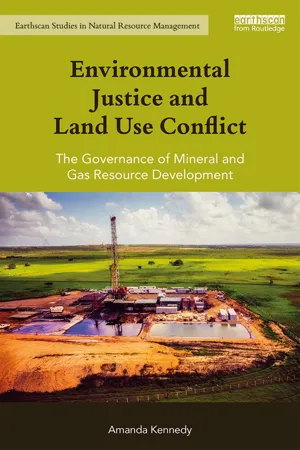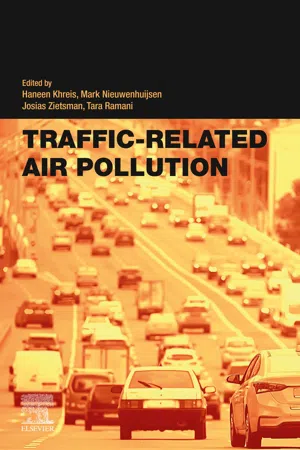Environmental Injustice
Environmental injustice refers to the unequal distribution of environmental burdens and benefits among different social groups. This can include the disproportionate exposure to pollution and environmental hazards experienced by marginalized communities, as well as the lack of access to environmental resources and amenities. Environmental injustice is often rooted in systemic inequalities and can have significant social, economic, and health impacts.
6 Key excerpts on "Environmental Injustice"
- eBook - ePub
- Judith Shapiro(Author)
- 2013(Publication Date)
- Polity(Publisher)
...The Central European University Center for Environmental Policy and Law (2007) provides these useful articulations: A condition of environmental justice exists when environmental risks and hazards and investments and benefits are equally distributed with a lack of discrimination, whether direct or indirect, at any jurisdictional level; and when access to environmental investments, benefits, and natural resources are equally distributed; and when access to information, participation in decision making, and access to justice in environment-related matters are enjoyed by all. By contrast, An Environmental Injustice exists when members of disadvantaged, ethnic, minority or other groups suffer disproportionately at the local, regional (sub-national), or national levels from environmental risks or hazards, and/or suffer disproportionately from violations of fundamental human rights as a result of environmental factors, and/or denied access to environmental investments, benefits, and/or natural resources, and/or are denied access to information; and/or participation in decision making; and/or access to justice in environment-related matters. We note in these definitions the important themes of information access and transparency, public participation, fairness, and equity; we also see that Environmental Injustice issues can be expressed both as “brown” (pollution) problems or “green” (resource extraction) problems. Environmental Injustice thus occurs locally, regionally, and nationally; it also occurs internationally in a globalized world, as strong countries protect their own territories from degradation while pushing it onto more vulnerable ones...
- eBook - ePub
Achieving Environmental Justice
A Cross-National Analysis
- Bell, Karen(Authors)
- 2014(Publication Date)
- Policy Press(Publisher)
...TWO The concept and measurement of environmental justice Individually and collectively, people around the world have opposed Environmental Injustice for hundreds of years. 1 However, most commentators agree that the conceptualisation and use of the term ‘environmental justice’ first emerged in the 1980s, out of resistance to the siting of toxic facilities in black and other minority ethnic communities in the United States. A defining moment was the publication of research that reported that hazardous installations, such as toxic waste dumps, were often located in areas with higher percentages of ‘people of color’ (UCC, 1987). This study was followed by further investigations that confirmed that poor and minority ethnic communities in the US were disproportionately exposed to environmental hazards (for example, Bryant and Mohai, 1992; Adeola, 1994; Cutter, 1995) and received unequal protection under environmental law (for example, Kratch, 1995). These findings led to accusations of ‘environmental racism’ and the growth of an environmental justice movement made up of tenants’ associations, civil rights groups, agricultural workers, religious groups, non-governmental organisations (NGOs), academics, trades unions and other civil society organisations. However, unlike previous environmental groups in the US, which had focused on the protection of wilderness and endangered species, this movement focused on the environment in the workplace and the community. Therefore, the term ‘environmental justice’ was originally applied to the socio-spatial distribution of pollution within national borders and, in particular, environmental racism in facility siting. It has since been taken up in other parts of the world and, over the past decade, the concept of environmental justice and its associated research methodologies have begun to be used in other countries around the globe, though more often by political and academic elites than by local activists (Walker, 2012)...
- eBook - ePub
Environmental Justice
An Issue for Social Work Education and Practice
- Sondra Fogel, Carenlee Barkdull, Bret Weber, Sondra Fogel, Carenlee Barkdull, Bret Weber(Authors)
- 2018(Publication Date)
- Routledge(Publisher)
...However, the conceptual frame of environmental justice has not been widely used to explore international contexts but tends to focus on environmental hazards in the Global North. This study begins to fill this gap by assessing the applicability of environmental justice in Jam City, a poor community in Nairobi, Kenya. This study also provides a case of international Environmental Injustice to use as a teaching tool regarding these issues. Literature Review Environmental justice is at once a social activism movement, a policy discourse and a conceptual frame (Agyeman, 2014; Kütting, 2004) but the values underpinning the cause remain steady across its uses. Environmental justice argues that environmental degradation and power imbalances are joined (Martinez-Alier, 2014; Nixon, 2011). Structural conditions drive hazardous conditions to the most marginalized people (Robbins, 2014). Thus, the main victims of Environmental Injustice are also typically victimized by other injustices (Mohai, Pellow, & Roberts, 2009; Nixon, 2011). A key component of this argument is that decisions about environmental harms are rooted in oppression and control (Sikor & Newell, 2014). Therefore, there is little participation from marginalized communities in decisions about the environmental risks and hazards that affect them (Sikor & Newell, 2014). These communities also often do not have equal access to the benefits that result from the environmental changes, which perpetuates the injustice of disproportionate environmental burdens (Minkler, Vasquez, Tajik, & Petersen, 2008). The importance of this intersectionality of marginalization and environmental degradation is because of the disparate impacts in wellbeing and quality of life in affected communities (Ravi Rajan, 2014)...
- eBook - ePub
Environmental Justice and Land Use Conflict
The governance of mineral and gas resource development
- Amanda Kennedy(Author)
- 2017(Publication Date)
- Routledge(Publisher)
...Efforts to define justice within the distributive paradigm have thus largely focused upon how to structure the allocation of substantive benefits and burdens within society; such a focus also occurs within the concept of environmental justice. Distributive environmental justice is concerned with the equitable sharing of environmental benefits and burdens across the population. A significant focus of much of the early environmental justice research was upon identifying patterns of uneven distribution among vulnerable groups, including Indigenous communities, communities of colour and the poor, who have been repeatedly found to be disproportionately impacted by environmental risks and harms (Schlosberg 2007; Figueroa 2003). Over time, however, the focus on proximity to harm has been broadened to other categories of disadvantage, most notably political inequality (Walker 2009, 2012). Environmental justice is, therefore, no longer exclusively concerned with tracing the distribution of harm within impoverished and minority neighbourhoods; it can be ‘analysed within and between “communities” (however defined) where one community is more vulnerable to environmental deterioration than the other’ (Jessup 2013: 77). Accordingly, environmental justice scholarship has more recently turned its attention to spaces of political power and vulnerability within and between different scales (e.g...
- eBook - ePub
Traditions and Trends in Global Environmental Politics
International Relations and the Earth
- Olaf Corry, Hayley Stevenson, Olaf Corry, Hayley Stevenson(Authors)
- 2017(Publication Date)
- Routledge(Publisher)
...7 Justice discourses and the global environment Diverse perspectives on an uneven landscape Ross Gillard, Lucy Ford and Gabriela Kütting Introduction Discussions of justice in Global Environmental Politics (GEP) have taken on many different hues. Questions of equitable access to clean environments and natural resources are central to environmental justice discourses. They seek to expose the unequal distribution of environmental degradation and challenge the uneven recognition of different groups’ interests in governing environmental issues. Often couched within traditional state-centric dichotomies of ‘North/South’ or ‘developed/developing’ relations, a range of justice issues has emerged within international debates about sustainable development, global environmental governance and development entitlements. Sociological considerations are essential to identifying the often racial, class-based and gendered nature of Environmental Injustice; something feminist theory has developed through the concept of intersectionality (Davis 2008; Kaijser and Kronsell 2014; Lykke 2010). For example, the unequal access some groups have to knowledge and power can affect the distribution of environmental ills within and across state boundaries. Such procedural justice issues of access to power and voice raise questions about inclusivity in environmental governance, inter-generational justice, and the challenge of representing multiple concerns in complex environmental decision-making. Further, a deep green perspective has sought to move away from the anthropocentrism of traditional social justice discourses by challenging nature/society distinctions, relocating humans within a broadly ecocentric perspective and extending the notion of rights to the non-human world...
- eBook - ePub
- Haneen Khreis, Mark Nieuwenhuijsen, Josias Zietsman, Tara Ramani, Haneen Khreis, Mark Nieuwenhuijsen, Josias Zietsman, Tara Ramani(Authors)
- 2020(Publication Date)
- Elsevier(Publisher)
...metropolitan areas. Environmental Health Perspectives. 2006;114(3):386–393. Morello-Frosch R., Pastor M., Sadd J. Environmental justice and Southern California’s “riskscape”: The distribution of air toxics exposures and health risks among diverse communities. Urban Affairs Review. 2001;36(4):551–578. Patton A.P., Zamore W., Naumova E.N., Levy J.I., Brugge D., Durant J.L. Transferability and generalizability of regression models of ultrafine particles in urban neighborhoods in the Boston area. Environmental Science & Technology. 2015;49(10):6051–6060. Pearce J.R., Richardson E.A., Mitchell R.J., Shortt N.K. Environmental justice and health: The implications of the socio-spatial distribution of multiple environmental deprivation for health inequalities in the United Kingdom. Transactions of the Institute of British Geographers. 2010;35(4):522–539. Schweitzer L., Valenzuela A. Environmental Injustice and transportation: The claims and the evidence. Journal of Planning Literature. 2004;18(4):383–398. Section 17213 of the California Education Code and section 21151.8 of the California Public Resources Code, (2003). Stephens B., Siegel J.A. Ultrafine particle removal by residential heating, ventilating, and air-conditioning. filters. Indoor Air. 2013;23(6):488–497. United Church of Christ. Commission for racial justice. Toxic wastes and race in the United States: A national report on the racial and socio-economic characteristics of communities with hazardous waste sites. New York, NY: Public Data Access: Inquiries to the Commission; 1987.xvi [69 pp]. Verbeek T. Unequal residential exposure to air pollution and noise: A geospatial environmental justice analysis for Ghent, Belgium. SSM—Population Health. 2019;7:100340. Walker G. Environmental justice: Concepts, evidence and politics. Routledge; 2012. Williams D.R., Lawrence J.A., Davis B.A. Racism and health: Evidence and needed research. Annual Review of Public Health. 2019;40:14.1–14.21....





